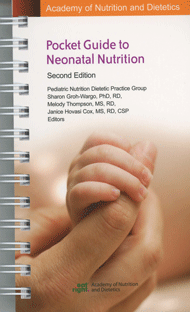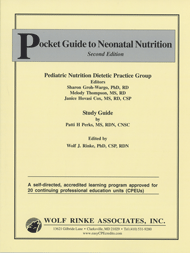|
Pocket Guide to Neonatal Nutrition, Second Edition
Pediatric Nutrition Dietetic Practice Group
Editors: Sharon Groh-Wargo, PhD, RD; Melody Thompson, MS, RD; Janice Hovasi Cox, MS, RD, CSPStudy Guide by Patti H Perks, MS, RDN, CNSC
Edited by Wolf J. Rinke, PhD, CSP, RDN
Pocket Guide, 263 pgs, and Study Guide with 1 Reporting Form, 26 pgs.
An indispensable CPE program for RDNs working with premature infants. Great resource to help you pass your Board Certification as a Specialist in Pediatric Nutrition (CSP).The easy-to-use format presents practical information on topics including:
- nutrition assessment,
- parenteral and enteral nutrition,
- medical/surgical conditions,
- discharge and follow-up, and
- conversion tables.
Includes key updates to medical surgical conditions and growth charts, addresses parenteral nutrition shortages and new enteral products, and discusses safety issues with the use of thickeners.
For more information and customer comments, click
here.
Approved/Accepted byCDR
For RDs/RDNs & DTRs/NDTRs for the Professional Development
Portfolio
SUGGESTED Performance Indicators (PIs):
2.1.1, 6.1.4, 6.3.6, 8.1.1, 8.1.2, 8.1.4, 8.1.5, 8.2.1, 8.3.1, 8.3.6, 10.1.1, 10.1.2, 10.1.3, 10.2.1, 10.2.1, 10.2.2, 10.2.3, 10.2.4,10.2.7, 10.2.9, 10.2.10, 10.2.11, 10.2.12, 12.3.2, 12.4.2, 12.4.6
DON'T SEE your Performance Indicators Listed here?
There are many Performance Indicators (PIs) that are applicable we can't list them all & Per CDR you may use ANY PI as long as it relates to your Learning Plan.
For details click here.
Share with a friend and Save! Click here for important information about
sharing.
To order an ADDITIONAL Reporting Form click below:
| C298F |
20 CPEUs |
REPORTING FORM |
|
|
Pocket Guide to Neonatal Nutrition, Second Edition
Pediatric Nutrition Dietetic Practice Group
Editors: Sharon Groh-Wargo, PhD, RD; Melody Thompson, MS, RD; Janice Hovasi Cox, MS, RD, CSPStudy Guide by Patti H Perks, MS, RDN, CNSC
Edited by Wolf J. Rinke, PhD, CSP, RDN
©2017 Wolf Rinke Associates. No part of this
publication may be reproduced, stored in a retrieval system, or transmitted
in any form or by any means, electronic, mechanical, photocopying,
recording, scanning, or otherwise, without the prior written permission
of the Publisher.
CUSTOMER COMMENTS
Alexis Richardson - "I really had to think about why each answer was correct, instead of just being able to read the book and getting the answers easily. I feel like I actually learned."
Sarah J. White - "I like how it was comprehensive and provided a great pocket guide tool."
OVERVIEW AND INSTRUCTIONS
Welcome to the pre-approved, accredited CPE program for the Pocket Guide to Neonatal Nutrition, Second Edition. The program consists of the Pocket Guide of the same title by the Pediatric Nutrition Dietetic Practice Group and this study guide. This CPE program is designed to help you apply the information in the study guide to patient-based scenarios. It is also designed to help you earn 20 Level 2, Continuing Professional Education Units (CPEUs).
To get the most out of this CPE program, it is suggested that you adhere to the following four steps:
- Review the objectives in this study guide.
- Read and study the Pocket Guide.
- Assess what you have learned by answering the self-assessment questions in this study guide.
- Compare your answers to the answer key, which you will find at the end of the study guide. If you scored at least 80% (40 questions) correct, you have completed the program and are ready to transfer your answers to the CONTINUING PROFESSIONAL EDUCATION REPORTING FORM in front of this study guide. If you scored less than 80% correct, re-read the appropriate sections of the Pocket Guide until you score at least 80% (40 questions) correct.
- After you have successfully completed the program, complete the CPE REPORTING FORM and:
Submit on-line at www.easyCPEcredits.com,
Or fax to: (410) 531-9282,
Or mail to: Wolf Rinke Associates, 721 Valley Forge Road #486, Valley Forge, PA 19481
We will email your Certificate of Completion.
When you submit your CPE Reporting Form to us via www.easyCPEcredits.com, fax, or mail be sure to write your correct email address in the space provided on the CPE Reporting Form. If writing by hand, be sure to print your email address clearly.
To ensure that our emails are delivered to your inbox (instead of your junk/spam folders), please add cpesupport@wolfrinke.com to your Address Book or Safe List of allowed email senders. Also, be sure to allow attachments from this email address.
LEARNING OBJECTIVES
Upon completion of this CPE program you will be better able to:
-
Apply components of nutrition assessment of infants with various clinical conditions;
-
Evaluate growth using appropriate growth curves to characterize growth for various infant populations;
-
Determine adequate and appropriate growth goals for infants;
-
Apply principles of nutrition assessment and growth to formulate patient-focused nutrition interventions;
-
Discuss limitations and use of biochemical assessment in infants pertinent to nutrition assessment and monitoring;
-
Calculate enteral intakes from prescribed feeding regimens;
-
Prescribe appropriate and recommended parenteral nutrition goals for preterm infants;
-
Evaluate clinical conditions impacting parenteral nutritional needs and delivery;
-
Recognize biochemical indicators that may warrant adjustment of the parenteral nutrition prescription;
-
Identify risk factors for necrotizing enterocolitis (NEC) and appropriate nutrition interventions to help prevent NEC, and used post-NEC;
-
Discuss strategies for management of parenteral nutrition-associated cholestasis;
-
Recommend an appropriate method for cycling parenteral nutrition in infants;
-
Discuss use of human milk in enteral nutrition;
-
Evaluate variables affecting risk of metabolic bone disease in infants;
-
Recommend options for fortification of human milk appropriate to the infant’s gestational age;
-
Suggest acceptable infant feeding substitutes for human milk based on the infant’s clinical condition;
-
Increase caloric concentrations of infant formula recipes;
-
Evaluate potential nutrients of concern for infants with short bowel syndrome;
-
Apply knowledge of nutrition assessment and nutrition support to infants with congenital heart disease, chronic lung disease, and gastroesophageal reflux; and
-
Discuss essential components of discharge nutrition plans and follow-up for infants.
TABLE OF CONTENTS
Contributors
Reviewers
Neonatal Terminology and Abbreviations
Chapter 1: Nutrition Assessment
Laurie J. Benson Szekely, MS, RD, LD Melody Thompson, MS, RD, LD
Chapter 2: Parenteral Nutrition
Susan J. Carlson, MMSc, RON, CSP, LD, CNSC; Anne M. Kavars, MS, RON, LD, CNSC
Chapter 3: Enteral Nutrition
Amy Sapsford, RD, CSP, LD, CNSC Carrie Smith, MS, RD, LD
Chapter 4: Medical/Surgical Conditions Introduction
Janice Hovasi Cox, MS, RD, CSP
Chapter 5: Respiratory Disease
Janice Hovasi Cox, MS, RD, CSP
Chapter 6: Congenital Heart Disease
Emily Trumpower, RD, CSP, CNSC
Chapter 7: Necrotizing Enterocolitis
Michelle Johnson, RD, CSP, LD
Chapter 8: Short Bowel Syndrome
Michelle Johnson, RD, CSP, LD
Chapter 9: Hyperbilirubinemia
Amy Gates, RD, CSP, LD
Chapter 10: Congenital Anomalies of the Alimentary Tract
Amy Jones, MS, RD, LD, CLC
Chapter 11: Gastroesophageal Reflux Disease
Ann Lewis, RD
Chapter 12: Renal Function
Allison Prince, MS, RON, LD
Chapter 13: Neurology and Metabolic Disorders
Hunter Rametta, MS, RDN, LDN, CNSC
Chapter 14: Endocrinology
Amy Gates, RD, CSP, LD
Chapter 15: Osteopenia of Prematurity
Michelle Johnson, RD, CSP, LD
Chapter 16: Neonatal Abstinence Syndrome
Marsha Dumm, MS, RD, LD
Chapter 17: Discharge and Follow-up
Sharon Groh-Wargo, PhD, RD, LD
Appendix A: Nutrition Care Process
Janice Hovasi Cox, MS, RD, CSP
Appendix B: Conversion Tables
Janice Hovasi Cox, MS, RD, CSP
Index
ABOUT THE AUTHOR OF THE STUDY GUIDE
Patti H. Perks, MS, RDN, CNSC is a nutrition support specialist in the Neonatal ICU at the University of Virginia Children’s Hospital where she is also the assistant manager of Pediatric Nutrition Services. She is a founding board member and past president of the Virginia Neonatal Nutrition Association. Patti obtained her BS in Nutrition Science from Cornell University and her Masters in Nutrition from James Madison University. She completed her internship in Clinical Dietetics at the University of Virginia Health System. Patti has been a certified nutrition support specialist since 2001 and for over 15 years has provided nutrition support to hospitalized neonates. In addition to teaching dietetic interns and NICU RNs, Patti regularly presents to medical residents on the topic of neonatal nutrition and was awarded in 2013 and 2016 with the Wahoo Team Player award in recognition of her teaching and contributing to the success of her students.
ABOUT THE EDITOR OF THE STUDY GUIDE
Wolf J. Rinke, PhD, RDN, CSP is the president and founder of Wolf Rinke Associates, a company that has provided high quality CPE programs to nutrition professionals since 1990.
He earned a BS at Drexel University, a MS at Iowa State University, a PhD in Continuing and Vocational Education (Adult Ed) at the University of Wisconsin, and interned at Walter Reed Army Medical Center. He participated in a test item writer workshop sponsored by the Commission on Dietetic Registration (CDR).
Wolf is a past Adjunct Associate Professor, Graduate School of Management & Technology, University of Maryland, and a former Adjunct Faculty Member, School of Continuing Studies, The Johns Hopkins University.
He is the past president of the DC Dietetic Association and has been honored by the Academy with the Award for Excellence in the practice of Management; the Outstanding Dietitian of the Year Award; the Outstanding Service Award; and has delivered the Lenna Frances Cooper Lecture.
At the Academy he has served in numerous leadership roles including Chair, Scholarship Committee, DBC; Chair, Communication Committee, CDR; Chair, Area Coordinating Committee, COE; Chair, COE, and member of Resource for Education Programs Committee; Honors Committee; CDR, Licensure Panel and Ethical Practices Task Force; CDR; House of Delegates and Board of Directors.
He is the author of more than 500 articles, numerous CPE home-study programs, several popular books, and the free monthly eNewsletter Read and Grow Rich written specifically for savvy Nutrition Professionals like YOU!
Subscribe now at www.easyCPEcredits.com--you’ll be glad you did!
ACKNOWLEDGEMENTS
Special thanks to the following individuals for their careful review of this CPE program.
Eva Delaney, RDN, CNSC
Pediatric Dietitian
University of Virginia Children’s Hospital
Charlottesville, VA
Dena Goldberg, PhD, RD, CNSC
Neonatal Nutrition Specialist
Carilion Clinic Children's Hospital
and
Assistant Professor
Dept. of Pediatrics
Virginia Tech Carilion School of Medicine
Roanoke, VA
Kendra Glassman Perkey, MS, RD, CNSC
NICU Dietitian, Clinical Nutrition Manager
Rocky Mountain Hospital for Children
Denver, CO
If you prefer to order by phone, mail
or fax click below
or click here to contact us with
other questions.
For information about our other products and
services return to the sidebar at the top of the page.
|
|
|


